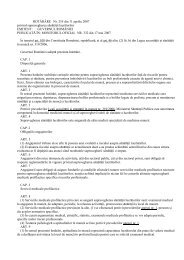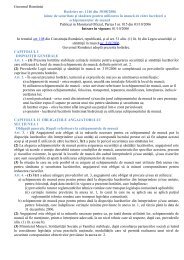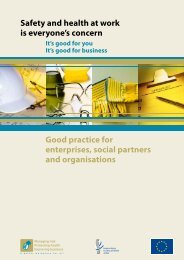Preventing work-related musculoskeletal disorders - European ...
Preventing work-related musculoskeletal disorders - European ...
Preventing work-related musculoskeletal disorders - European ...
Create successful ePaper yourself
Turn your PDF publications into a flip-book with our unique Google optimized e-Paper software.
<strong>Preventing</strong> <strong>work</strong>-<strong>related</strong> <strong>musculoskeletal</strong> <strong>disorders</strong><br />
VEERLE HERMANS AND RIK OP DE BEECK<br />
<strong>European</strong> Agency Topic Centre on Research: Work and Health, PREVENT, Belgium<br />
t he scientific agenda<br />
While gaps remain in our knowledge of MSDs,<br />
considerable advances have been made in<br />
recent years.<br />
mechanical properties of soft tissues. For low levels of biomechanical<br />
stressors, the evidence is less definitive, although some studies<br />
suggest causal associations. And this seems to be an important topic<br />
for further research.<br />
Recent decades have seen a growing interest amongst scientists in the<br />
subject of <strong>musculoskeletal</strong> <strong>disorders</strong> (MSDs) <strong>related</strong> to the <strong>work</strong>place,<br />
as the number of <strong>work</strong>ers suffering from these <strong>disorders</strong> has steadily<br />
increased. As industry has come to pay greater attention to<br />
ergonomics, much effort has been put into improving our knowledge<br />
on MSDs. And although some discrepancies are still present in the<br />
literature, there’s now a broad consensus on priorities based on the<br />
available scientific knowledge.<br />
SCIENTIFIC KNOWLEDGE<br />
The relationship between MSDs and <strong>work</strong> seems to be multi-factorial<br />
with risk factors in the physical, personal and psychosocial domain.<br />
Rigorous review studies have explored the general importance and<br />
occurrence of these risk factors and enabled a number of general<br />
conclusions to be drawn.<br />
Several types of study contribute to the augmentation of scientific<br />
knowledge. Studies in epidemiology seek to find associations<br />
between exposure and disease (cause or risk factor and effect). Both<br />
cohort or case-control studies including longitudinal studies, although<br />
not often performed, are important sources for information. Exposure<br />
measurements used in <strong>work</strong>-<strong>related</strong> MSD studies range from very<br />
crude measures to more complex analytical techniques. Furthermore,<br />
more refined research methods in laboratories are helping to broaden<br />
our understanding of the biochemical and biomechanical properties<br />
of body structures and their possible role in the development of MSDs.<br />
The scientific knowledge from all these studies can be used in the<br />
understanding of the aetiology of MSDs, in the development of<br />
prevention strategies to prevent or reduce MSDs and also in the<br />
development of regulations and guidelines.<br />
EPIDEMIOLOGICAL EVIDENCE<br />
The epidemiological evidence for <strong>work</strong>-<strong>related</strong> MSD, has been<br />
reviewed recently by several institutes and committees of researchers.<br />
Individual, organisational-social and physical factors were<br />
characterised. These factors are presented in the conceptual<br />
frame<strong>work</strong> of the National Research Council (Table 1). But what is the<br />
general scientific evidence from the epidemiological studies?<br />
Studies of the highest levels of exposure, biomechanical (physical) risk<br />
factors (repetition, force, posture, and vibration) have revealed a<br />
positive relationship between MSDs and <strong>work</strong>. Often biomechanical<br />
loads are produced on the human body that approach the limits of the<br />
<strong>European</strong> Agency for Safety and Health at Work<br />
Table I: Conceptual frame<strong>work</strong> of physiological pathways and factors that potentially<br />
contribute to <strong>musculoskeletal</strong> <strong>disorders</strong> (National Research Council, 1999)<br />
Work procedures,<br />
equipment and<br />
environment<br />
Organisational<br />
factors<br />
Social context<br />
Symptoms<br />
Physiological<br />
pathways<br />
Load<br />
Response<br />
Impairment<br />
Disability<br />
Adaptation<br />
Individual, Physical<br />
and Psycho-logical<br />
Factors and<br />
Non-<strong>work</strong> <strong>related</strong><br />
activities<br />
It is acknowledged that individual factors may influence the degree of<br />
risk from specific exposures. Prior medical history is considered one of<br />
the main contributors to the development of MSDs. On the<br />
organisational-social level, factors directly associated with stress (low<br />
job content, high job demands and low social support) have recently<br />
also been identified as being important.<br />
RISK ASSESSMENT METHODS<br />
As a result of the growing interest in ergonomics in industry over the<br />
last decades, much effort has been put into improving the usability<br />
and effectiveness of assessment techniques in the field using a holistic,<br />
participatory and integrated approach. There exists a variety of risk<br />
assessment methods to measure exposure to physical risk factors,<br />
ranging from very crude measures (e.g., occupational title) to complex<br />
analytical techniques. Information on <strong>work</strong>place measurements for<br />
practitioners is given later in this magazine. Furthermore, more refined<br />
research methods in laboratories are performed. Careful<br />
characterisation of clinical findings and neurological examinations of<br />
sensory changes and muscular weakness can help in the localisation<br />
of a possible morphological/anatomical lesion and assist in the<br />
differential diagnosis and treatment. New techniques are being used<br />
to understand more about the aetiology of MSDs (e.g. near infrared<br />
spectroscopy, analysis of endplate fractures in vitro, laser-Doppler<br />
flowmetry, …). It is aimed at obtaining more information as to why<br />
some people are at greater risk of developing MSDs than others and<br />
<br />
11








